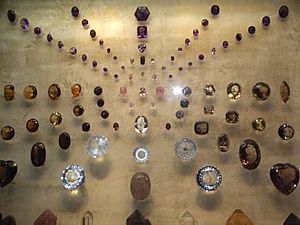Harry Frank Guggenheim Hall of Gems and Minerals facts for kids
The Guggenheim Hall is an amazing exhibit at the American Museum of Natural History in New York City. It holds one of the world's biggest collections of rocks and minerals. Here, you can learn about how rocks are made, how minerals form, and even how people have used gems for ages. It's also the permanent home of the Star of India. This is one of the largest and most famous star sapphires in the world! A famous critic once called it "one of the finest museum installations." This hall is part of the museum's Earth and Planetary Sciences department.
Contents
History of the Hall
The Harry Frank Guggenheim Hall of Minerals displays hundreds of unique rocks and minerals. It's connected to the Morgan Memorial Hall of Gems, which shows off many rare and valuable gemstones. The exhibit was designed by Wm. F. Pedersen and Assoc. with Fred Bookhardt leading the project. It took six years to create, from 1970 to 1976.
In 1964, some very famous gems were taken from the Museum. These included the Star of India, the Eagle Diamond, the DeLong Star Ruby, and the Midnight Star. Luckily, the Star of India was found later in a locker in a Miami bus station! The DeLong Star Ruby was also recovered. However, the Eagle Diamond was never found.
Amazing Exhibits
The museum has over 100,000 pieces in its collection. Many of the most famous ones are on display here!
The Patricia Emerald
One incredible piece is the Patricia Emerald. It weighs 632 carats (about 126 grams). This gem is known as one of the world's greatest emeralds because of its huge size and beautiful color. It's also special because it has 12 sides! It was found in 1920 in a mine high in the Colombian Andes. The Patricia is one of the few large, high-quality emeralds that has never been cut.
The Star of India
You can also see the 563-carat (113 gram) Star of India. This is the largest and most famous star sapphire in the world! It was discovered over 300 years ago in Sri Lanka. It was likely found in ancient river beds, where sapphires are still found today. A rich financier named J.P. Morgan donated it to the Museum.
The thin, glowing, six-pointed star you see on the sapphire is called an asterism. It's created when light bounces off tiny, needle-like crystals of a mineral called rutile inside the sapphire. The Star of India is polished into a smooth, dome shape called a cabochon. This helps make the star even more beautiful!
Other Notable Gems and Minerals
Other cool things on display include a giant 596-pound (270 kg) topaz. There's also a huge 4.5-ton piece of blue azurite and malachite ore. This was found in the Copper Queen Mine in Bisbee, Arizona, a long time ago. You can also see a rare, 100-carat (20 gram) orange-colored padparadschan sapphire from Sri Lanka. It's considered very special! The collection also has the Midnight Star Ruby, which is a 116.75-carat deep purplish-red star ruby.
Images for kids
-
Labradorite specimen
-
Quartz var. amethyst geode
-
Quartz var. agate geode







